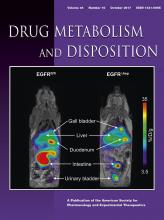Abstract
Flavin-containing monooxygenases (FMO) are metabolic enzymes mediating the oxygenation of nucleophilic atoms such as nitrogen, sulfur, phosphorus, and selenium. These enzymes share similar properties to the cytochrome P450 system but can be differentiated through heat inactivation and selective substrate inhibition by methimazole. This study investigated 10 compounds with varying degrees of FMO involvement to determine the nature of the correlation between human in vitro and in vivo unbound intrinsic clearance. To confirm and quantify the extent of FMO involvement six of the compounds were investigated in human liver microsomal (HLM) in vitro assays using heat inactivation and methimazole substrate inhibition. Under these conditions FMO contribution varied from 21% (imipramine) to 96% (itopride). Human hepatocyte and HLM intrinsic clearance (CLint) data were scaled using standard methods to determine the predicted unbound intrinsic clearance (predicted CLint u) for each compound. This was compared with observed unbound intrinsic clearance (observed CLint u) values back calculated from human pharmacokinetic studies. A good correlation was observed between the predicted and observed CLint u using hepatocytes (R2 = 0.69), with 8 of the 10 compounds investigated within or close to a factor of 2. For HLM the in vitro-in vivo correlation was maintained (R2 = 0.84) but the accuracy was reduced with only 3 out of 10 compounds falling within, or close to, twofold. This study demonstrates that human hepatocytes and HLM can be used with standard scaling approaches to predict the human in vivo clearance for FMO substrates.
Footnotes
- Received July 3, 2017.
- Accepted August 4, 2017.
↵
 This article has supplemental material available at dmd.aspetjournals.org.
This article has supplemental material available at dmd.aspetjournals.org.
- Copyright © 2017 by The American Society for Pharmacology and Experimental Therapeutics
DMD articles become freely available 12 months after publication, and remain freely available for 5 years.Non-open access articles that fall outside this five year window are available only to institutional subscribers and current ASPET members, or through the article purchase feature at the bottom of the page.
|







